To choose the perfect rug for your space, start by evaluating your traffic levels and family needs. Measure your area, ensuring 18-30 inches of walkways around the rug. Select a size that fits your furniture; living rooms typically need 8×10′ or 9×12′ rugs. Consider materials that suit your lifestyle, like durable wool or easy-care synthetics. Don’t forget to match the rug’s aesthetic with your decor for a cohesive look. Discover more tips to elevate your rug selection process!
Key Takeaways
- Assess the traffic level in your space to select durable materials suited for high-traffic areas, like wool or synthetic blends.
- Measure your room accurately and allow for 18-30 inches of clear pathways around the rug to avoid a cramped feel.
- Choose a rug that complements your existing decor and color scheme, ensuring it enhances the overall aesthetic of the room.
- Select the right size based on room function, such as 8×10 feet for living rooms and extending at least 24 inches in dining areas.
- Consider material maintenance; opt for low-pile rugs in busy spaces and high-pile rugs for cozy areas, keeping cleaning ease in mind.
Key Considerations Before Buying a Rug
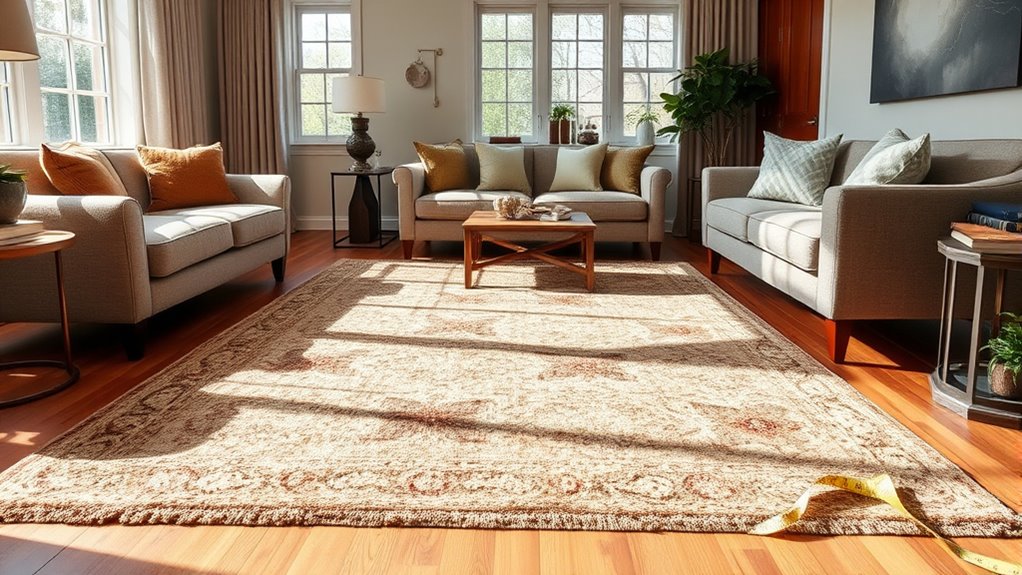
Before you plunge into buying a rug, it’s crucial to reflect on several key factors that will ultimately influence your decision.
First, assess the traffic level in your space; high-traffic areas require durable materials like wool or synthetic blends. If you have kids or pets, prioritize family-friendly options that can withstand spills and stains.
Next, measure the room accurately to verify the rug size fits well with furniture, allowing for 18-30 inches of traffic paths around it.
Your rug’s aesthetic should complement your existing decor, so think about color palettes that enhance your space.
Finally, set a budget before shopping, as prices vary greatly based on material choices, size, and design. Don’t forget to contemplate rug pads for added comfort and stability.
Choosing the Right Size and Shape
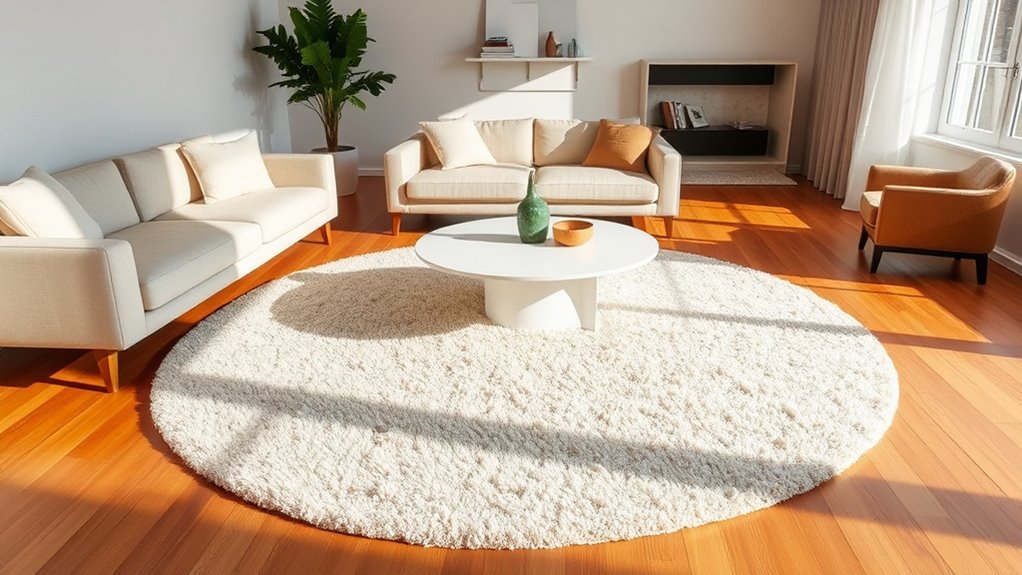
Understanding the right size and shape for your rug can greatly enhance the overall look and functionality of your space.
Start by measuring your seating area to determine the correct rug size. For a living room rug, typical dimensions are 8×10′ or 9×12′, while a dining room rug should extend at least 24 inches beyond the table for easy chair movement.
In bedrooms, aim for a rug that extends at least 24 inches on three sides of the bed for proper proportion. Also, verify you have 18-30 inches of clear walkway around the rug to avoid a cramped feel.
Use painter’s tape to visualize your rug layout and confirm it fits well with furniture placement before purchasing.
Material Selection and Maintenance
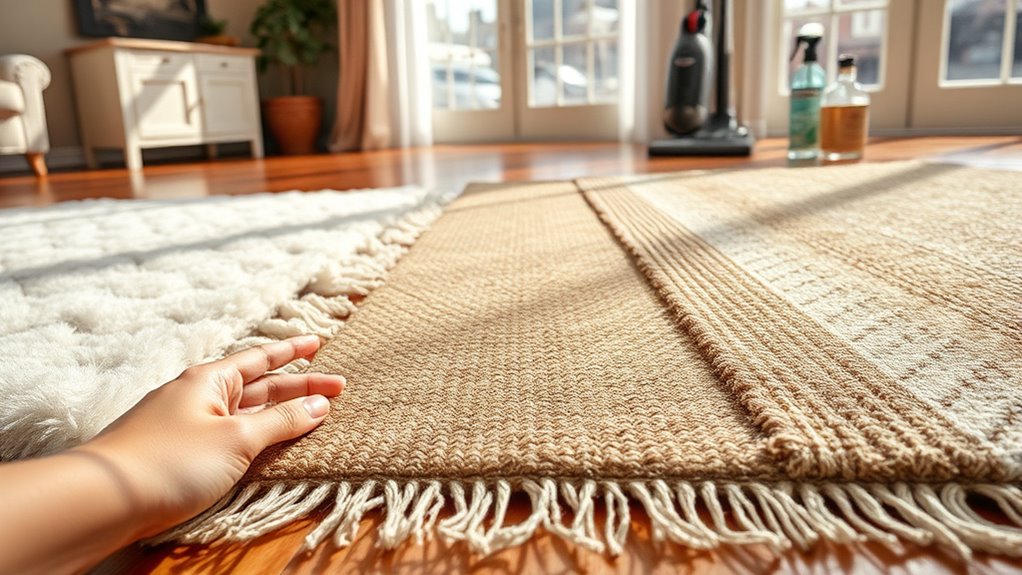
Choosing the right material for your rug is essential, as it directly impacts both aesthetics and functionality. When considering material selection, think about your space’s foot traffic and maintenance needs. Natural fibers like wool and cotton provide durability and are allergy-friendly, while synthetic fibers like polyester and polypropylene offer affordability and easy cleaning for high-traffic areas. Here’s a quick comparison:
| Material Type | Best For | Maintenance |
|---|---|---|
| Natural Fibers | Allergy sufferers | Blot and brush stains |
| Synthetic Fibers | High-traffic areas | Spot clean, steam clean |
| Low-Pile Rugs | Entryways, busy rooms | Regular vacuuming |
| High-Pile Rugs | Cozy spaces, bedrooms | Gentle vacuuming |
| Rug Pad | Protect floors, enhance comfort | N/A |
Regular rug maintenance will help prolong your investment!
Aesthetic Considerations and Style
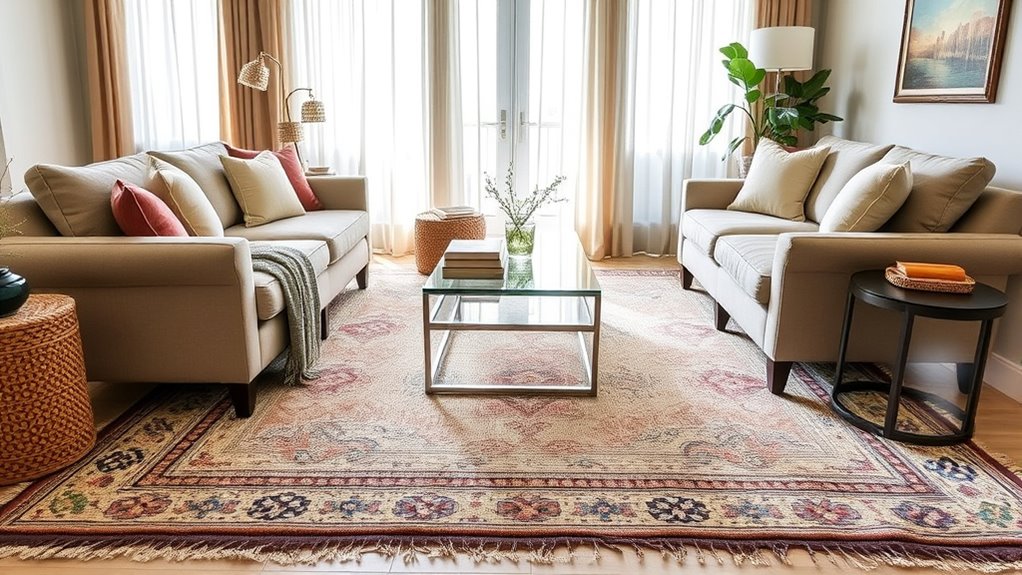
While maintaining your rug’s material is important, aesthetic considerations play an essential role in creating a harmonious space.
Start by selecting a rug that complements your room’s color palette; lighter hues promote spaciousness, while darker shades add intimacy.
Consider the contrast between patterned rugs and solid colors; a bold patterned rug can become a stunning focal point, whereas subtle designs balance the decor.
Vintage rugs introduce unique texture and character, blending old and new styles beautifully.
Layering rugs also adds depth—pair a larger, neutral rug with a smaller, colorful one for visual interest.
Finally, think about the room’s function; casual spaces may benefit from natural fibers, while formal areas might require elegant patterns or luxurious materials. Additionally, incorporating natural materials like jute or wool can enhance the farmhouse aesthetic in your decor.
Room-Specific Rug Guidelines
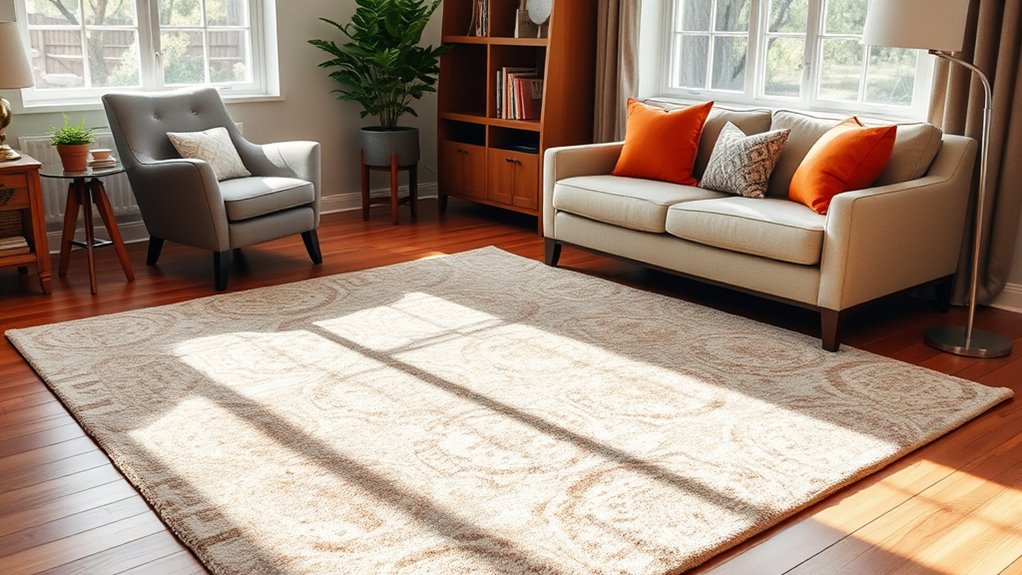
When it comes to choosing the right rug for each room, there are specific guidelines to keep in mind.
In the living room, bedroom, and dining room, the size and placement of your rug can make a big difference in both function and style.
Let’s explore how to select the perfect rug for each of these spaces.
Living Room Essentials
To create a comfortable and inviting living room, selecting the right rug is essential. Choose a rug size of 8×10 or 9×12 feet to guarantee that the front legs of your sofa and chairs sit on it, creating a cohesive look.
Ideally, the rug should extend at least 6 inches beyond the sides of the sofa, with 8 inches being ideal for visual balance. Maintain a walkway of 30 to 36 inches between large furniture pieces; if space is tight, a minimum of 18 to 24 inches works too.
For a unified design, keep all furniture legs either on or off the rug. Finally, orient the rug along the sofa’s length to enhance the room’s flow and layout.
Bedroom Comfort Guidelines
Creating a comfortable living space extends beyond the living room; your bedroom deserves just as much attention when it comes to choosing the right rug.
Here are some guidelines to enhance your bedroom’s comfort:
- Rug Size: Select sizes like 5×8 for Twin, 6×9 for Full, 8×10 for Queen, and 9×12 for King beds to guarantee adequate coverage.
- Placement: Your bedroom rug should extend at least 24 inches on three sides of the bed for a balanced look.
- Pile Height: Opt for mid-to-high-pile rugs for ultimate comfort underfoot.
- Rug Pad: Add a rug pad for extra cushioning and stability, enhancing the rug’s lifespan while maintaining visual symmetry.
With these tips, you’ll create a cozy retreat that feels inviting and stylish.
Dining Room Considerations
How can you elevate your dining room’s style while ensuring practicality? Start by selecting area rugs that extend at least 24 inches beyond your dining table. This allows for easy chair movement and a balanced look. For high-traffic areas, opt for low-pile rugs that facilitate cleaning and prevent bunching. Keep at least 12 inches of space between the rug and walls for visual breathing room.
Here’s a quick guide to rug sizes:
| Rug Size | Ideal Table Shape | Dimensions |
|---|---|---|
| 9×12 feet | Rectangular | 9′ x 12′ |
| 10×14 feet | Rectangular | 10′ x 14′ |
| 8-foot round | Round | 8′ diameter |
| 8×10 feet | Square/Rectangular | 8′ x 10′ |
| 5×8 feet | Small spaces | 5′ x 8′ |
Choose colors and patterns wisely to hide spills!
Shopping Tips for the Perfect Rug
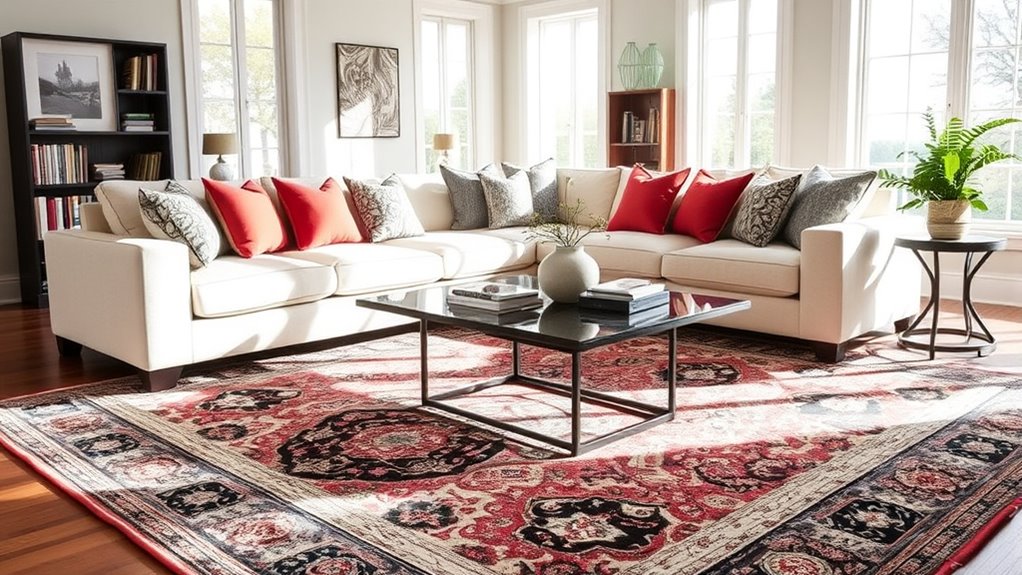
Wondering how to find the perfect rug for your space? Here are some tips to guide your shopping:
- Measure your space accurately with painter’s tape to guarantee the rug fits well with your furniture and allows for comfortable movement.
- Consider the style of your room; choose a rug that complements your décor, whether it’s modern or eclectic.
- Select materials based on the rug’s location. Natural fibers like wool are durable but pricier, while synthetics are easier to clean.
- Assess foot traffic; opt for low-pile rugs in high-traffic areas for easy maintenance, or high-pile rugs for added comfort, keeping in mind they require more upkeep.
Don’t forget a quality rug pad to protect your flooring and enhance comfort!
Frequently Asked Questions
How to Choose the Right Rug for Your Space?
To choose the right rug for your space, start by measuring the room and furniture layout.
You’ll want a rug that extends 6-12 inches beyond your furniture for a cohesive look.
Consider the material based on traffic levels; low-pile for busy areas and high-pile for comfort.
Match the rug’s style and color to your décor, and if you’ve got kids or pets, opt for durable, easy-to-clean materials.
Visualize the size with painter’s tape before buying.
What Is the 18 Inch Rule for Rugs?
The 18-inch rule for rugs suggests you should leave at least 18 inches of bare floor around the edges. This guideline creates a balanced feel and prevents the rug from looking like it’s floating.
In dining areas, it allows for smooth chair movement, while in living rooms, it helps define traffic paths and furniture relationships.
Adjust the spacing based on your room size to guarantee it doesn’t feel cramped or disjointed.
What Is the Rule of Thumb for Area Rugs?
When it comes to area rugs, a good rule of thumb is to guarantee your rug fits the furniture arrangement.
In living rooms, let the front legs of sofas and chairs rest on the rug.
For dining rooms, make certain the rug extends beyond the table for chair movement.
In bedrooms, aim for at least 24 inches on three sides of the bed.
Always leave 18-30 inches of bare floor around the edges for balance.
Should Area Rug Be Lighter or Darker Than Couch?
When deciding if your area rug should be lighter or darker than your couch, consider the effect you want to achieve.
Lighter rugs can brighten a space and create an airy feel, while darker rugs add warmth and intimacy. Aim for a rug that’s one to two shades lighter or darker than your couch to avoid a monotone look.
Just keep in mind that lighter rugs may show dirt more easily than darker ones.
Conclusion
So, you thought choosing a rug would be a breeze? Ironically, it’s more like a treasure hunt—exciting, yet full of twists! Remember, the right rug can transform your space from drab to fab, but it takes a bit of effort. Embrace the hunt, consider those key factors, and don’t rush. After all, who knew that a piece of fabric could hold the power to make or break your entire room? Happy rug hunting!









